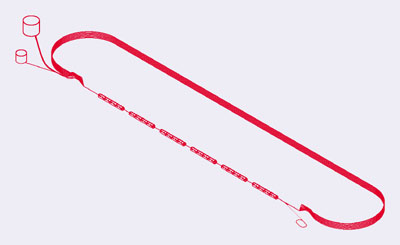
As experiments at CERN using high-energy nuclear beams have shown, about one ten-thousandth of a second after the Big Bang, its quarks and gluons crystallized into protons and neutrons, changing for ever the texture of the microworld and casting the form for the nuclear matter that dominates our universe. In physics-speak, free quarks became “confined” in subnuclear particles, where they have remained ever since.
Once accomplished, this quark confinement is extremely difficult to unravel, and CERN’s experimental programme using high-energy nuclear beams has shown that recreating these initial Big Bang conditions requires energy, perseverance and insight.
However, the quark/gluon origins of nuclear matter are now well understood. Less well understood is how the complex pattern of nuclear matter that we see around us relates to, and results from, quark-gluon confinement. It is somewhat analogous to the realization that all biology can ultimately be related to the DNA structure of genetic material. However, until the underlying genome structure is revealed through detailed experiments, the connections are difficult, if not impossible, to make and the science remains highly empirical.
Nuclear physics therefore needs a “genome project” to map its quark/gluon structure. This underlies the Electron Laboratory for Europe (ELFE) proposal for continuous electron beams in the 15-30 GeV range. ELFE is promoted by the Nuclear Physics European Collaboration Committee (NuPECC), which is the “parliament” of European nuclear physicists.
This requirement for powerful electron beams has resulted in several studies on both the physics and the machine sides. The first ELFE machine proposal in 1993 was for a “green field” design. A 1997 study at DESY, Hamburg, looked at the possibility of capitalizing on DESY’s plans for a new linear electron-positron collider. The latest machine study, at CERN, aims to exploit the valuable hardware and expertise that will become available when CERN’s 27 km LEP electron-positron collider is finally closed.
LEP will begin its 2000 operations in April, but from October the LEP schedule announces “LEP dismantling”, so the tunnel can be prepared for the LHC proton collider scheduled to begin operations in 2005.
In 1998 Günther Geschonke and Eberhard Keil at CERN published an idea for an electron machine based on “salvaged” LEP components, particularly its valuable super-conducting radiofrequency acceleration cavities. This idea now forms the focus of a conceptual design report, ELFE at CERN, which pulls together the underlying physics objectives, requirements for experiments and experimental areas, and the machine itself.
Cryogenics infrastructure, including helium compressors, installed for LEP will enjoy a prolonged life at the LHC and thus will not be available for ELFE.
The outcome of an intense R&D programme, LEP is now fitted with hundreds of niobium-covered radiofrequency cavities achieving accelerating gradients of 7 MV/m that push its beam energy to 100 GeV and even beyond.
In the ELFE at CERN scheme, these cavities would be redeployed in one straight section of a flat racetrack. The linac itself, with the LEP superconducting cavities, would be 1080 m long, but adding the elements to spread and combine the beams at each end takes the total length to 1500 m. The opposite straight section would have six vertically stacked beamlines to handle the successive passes of the beam, with a 3.5 GeV energy gain on each of the seven passes through the linac. With the required tight momentum spread in the beam (less than one part per thousand) influencing the bending that could be achieved, the two straight sections would be linked by 300 m diameter arcs. The new ring could be accommodated near CERN’s existing North Experimental Area, with experiments in or very near existing halls.
To maximize the scope of the experimental programme, ELFE is foreseen as handling polarized particles. These would be injected at 800 MeV either via a superconducting linac using experience gained from the TESLA international project based at DESY or via racetrack microtrons, as with the MAMI machine at Mainz.
The ELFE at CERN conceptual design report is now seen as definitive and will serve as input to future presentations of the study.
Further reading
H Burkhardt (ed.) ELFE at CERN, Conceptual Design ReportCERN/NuPECC, CERN 99-10.







